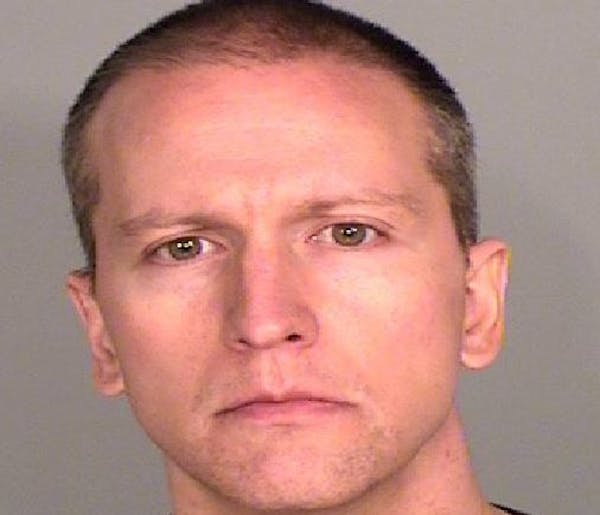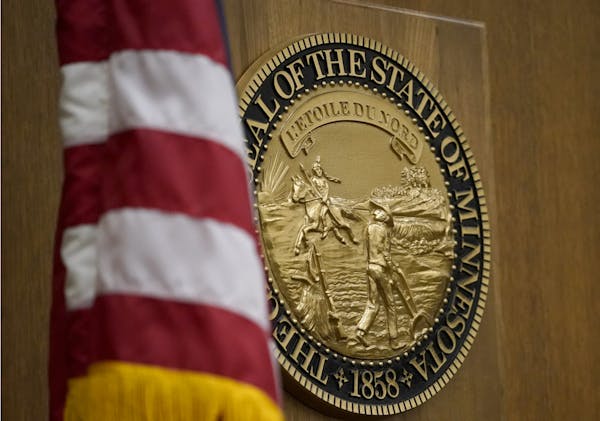Sobs of grief overcame a man testifying Wednesday afternoon in the Derek Chauvin murder trial as he watched video of himself standing watch as Minneapolis police struggled with George Floyd, who called out for his mother and shouted “I can’t breathe” on the night of his arrest and death last spring.
Charles McMillian said in Hennepin County District Court that he came upon the scene early on when police detained Floyd on suspicion of passing a fake $20 bill at the Cup Foods convenience store at E. 38th Street and S. Chicago Avenue.
McMillian said he tried to get Floyd to calm down as two officers fought to get him into the back of their squad car.
“I’m watching Mr. Floyd, I’m trying to get him to understand that when you make a mistake, once they get you in handcuffs, there’s no such thing as being claustrophobic, you have to go,” he said. “I’ve had interactions with officers myself, and I realize once you get in the cuffs you can’t win.”
Prosecutor Erin Eldridge played officer-worn body camera footage as exterior store surveillance video also rolled. It showed McMillian calmly and intently watching the officers having difficulty getting an increasing agitated Floyd into their squad.
Floyd cried “Momma, Momma, Momma” repeatedly and yell out that “I can’t breathe” on the video. Once the video stopped, the global livestream showed McMillian on the witness stand wiping away tears and fighting sobs.
“Helpless” is how McMillian said he felt as he watched Floyd and the officers. “I don’t have a momma either; I understand him.”
“Oh, my god,” the witness then uttered in a breathy whisper. With that, Judge Peter Cahill called for a brief break to give McMillian, 61, time regain his composure.
Earlier, McMillian testified that he recognized Chauvin and had seen him as recently as five days earlier.
“I pulled up to the squad car somewhere in south Minneapolis, and I see Mr. Chauvin, and I told him like I tell other officers — that the end of the day, you go home to your family safe and that the next person goes home to their family safe,” he said.
When proceedings resumed, newly released video from Chauvin’s body-worn camera showed McMillian confront the officer as he got into his squad after Floyd was taken away in an ambulance.
McMillian reminded Chauvin of what he had told him five days earlier, about getting home safe to his family, as the next person should be able to.
Chauvin then defended his actions, saying, “We’ve gotta control this guy because he’s a sizable guy, looks like he’s probably on something.”
Eldridge asked McMillian, “Why did you feel the need to talk to Mr. Chauvin?” McMillian replied: “Because what I watched was wrong.”
“And did you feel it was important to tell him?” Eldridge said.
“Yes, ma’am.” McMillian answered.
The proceedings ran until shortly after 4:30 p.m. The trial is set to resume Thursday sometime between 9 and 9:30 a.m.
George Floyd’s youngest brother occupied the lone family seat in the courtroom for the afternoon session and did not watch the video when the officers were trying to get George Floyd into the squad car. Rodney Floyd stared down, his eyes wide during that video moment.
When video was shown of George Floyd yelling “Mama” repeatedly and “I can’t breathe,” again Rodney Floyd averted his eyes while looking down and shaking his head. He had much the same reaction when video of the arrest was played later from each of the officers’ body-worn cameras.
During a break in the trial, the brother said in the hall that he did glimpse out of the corner of his eye at some of the video.
Earlier Wednesday, surveillance video was shown from inside the store where he bought cigarettes with suspected counterfeit currency before his deadly encounter with police late last spring.
In the footage disclosed publicly for the first time, Floyd ambled about Cup Foods for several minutes and appeared fidgety at times while chatting with others inside as Christopher Martin, a clerk in the store at the time, explained in testimony what was being shown. Floyd is seen inside the store with Morries Hall and Shawanda Hill, who were in the SUV when Floyd was first detained by police.
Late Thursday, Hall filed with the court his intention to invoke his Fifth Amendment constitutional privilege against self-incrimination. This would prevent Hall from testifying to anything that might work against the prosecution as it tries to convict Chauvin of killing Hall’s friend.
Chauvin is charged with second- and third-degree murder and manslaughter. Three other fired officers, J. Alexander Kueng, Thomas Lane and Thao, are expected to stand trial in August on charges of aiding and abetting murder and manslaughter.
Martin, who lived above the store, said Floyd eventually bought cigarettes with a $20 bill. Martin said the color of the bill made him suspicious that it was fake, and he went outside to talk to Floyd twice about it.
Eventually, someone called police and that set off the sequence of events that led to Floyd’s arrest under Chauvin’s knee and death later that night.
“When I saw the bill I noticed it had a blue pigment to it, kind of like a $100 bill would have, so I found that kind of odd and assumed it was fake,” said Martin, 19.
Martin said store policy meant that he would have to pay for any counterfeit currency he and his co-workers accepted.
“I took it anyway and was willing to put it on my tab, and then I second guessed myself,” he said.
Martin said he twice went out with co-workers trying in vain to get Floyd to come back in the store and deal with the suspected fake bill. Floyd didn’t say much and didn’t come back into the store.
“He just seemed like he didn’t, like, want this to happen, he was just kind of like ‘Ah, why is this happening?’ ” Martin said. He said his manager then directed his co-worker to call 911 and Martin went back about his business. Later, he heard commotion outside the store and saw Floyd pinned to the ground.
“George was motionless, limp,” Martin said, “and Chauvin seemed very, he was in a resting state, meaning like he rested his knee on his neck. I pulled my phone out first and called my mom and told her not to come downstairs and then I started recording.”
He said he later deleted the recording after he saw the ambulance drive in a direction not typically used to get to the hospital.
“That made it clear to me that he was no longer with us,” he said. Pressed on why he deleted the recording, he said, “I just didn’t want to have to show it to anyone and be questioned about it.”
Later in his testimony, Martin was asked why he could be seen on exterior store video surveillance pacing about near the arrest scene and clasping his hands atop his head.
“At this point I was kind of emotional,” he said, recalling a conversation with another Black man at the scene, saying, ” ‘They’re not gonna help him, this is what we have to deal with.’ ” Cahill ordered the comment stricken from the record.
Martin said he was feeling “disbelief and guilt.”
Why guilt? Prosecutor Matthew Frank asked.
“If I would have just not taken the bill, this could have been avoided,” Martin replied.
Afterward, he went back into the store and continued his shift, but he didn’t stay employed at the store long.
“I didn’t feel safe,” he said.
As for Floyd’s demeanor, Martin said he was amicable, and he saw him as just another customer. Martin noticed his size and asked Floyd whether he played baseball. Floyd told him that he played football.
“He went on to respond, but it kind of took him a little long to get to what he was trying to say so, it would appear that he was high,” Martin said.
The defense has focused in pretrial motions and during its opening statement on Floyd’s drug use and what impact it might have had on his health.
Nelson’s time questioning Martin dealt a fair amount with Floyd appearing to be under the influence of drugs.
He confirmed that he told investigators earlier that Floyd’s speech was delayed as he “was trying to form the words.”
Martin again said, this time under prosecution questioning, that Floyd was friendly and “just seemed to be enjoying just an average Memorial Day. But he did seem high.”
The day’s final witness was Police Lt. James Rugel, who oversees the department’s body-worn camera program. After Rugel explained how body cameras worked and when they are to be activated, prosecutor Steve Schleicher played much of the bodycam video on the night of Floyd’s arrest from officers Lane, Kueng and Thao.
They showed Lane and Kueng struggling to get Floyd in their squad car for minutes to get him in the squad. Chauvin soon arrived and joined the other two in getting Floyd on the pavement, where all three kept him pinned for more than nine minutes until paramedics arrived.
Schleicher then played last for the jury some of Chauvin’s bodycam video from that night. It started with Thao driving as he and Chauvin head to the scene. They arrived, and Chauvin walked toward where Lane and Kueng were struggling to get Floyd in the back of the squad.
Chauvin went around to the other side and helped Lane pull Floyd out. Chauvin’s bodycam then went to the ground. Earlier, Schleicher paused Lane’s video to show Chauvin’s detached bodycam. The playing of the Chauvin’s video stopped there.
Once the jury was dismissed, Nelson questioned Rugel about the city-operated camera video across from Cup Foods and about the four officers’ bodycam videos. The defense attorney then said the state’s submissions of those videos are not what those cameras captured in full, and he intends to enter into evidence this week the complete images from all those cameras.
In apparent connection to the video evidence, Nelson offered a hint of what areas he plans to address once it’s the defense’s turn after the prosecution rests its case, namely that he will have experts testify about “use of force considerations and medical issues.”
Early in Wednesday’s proceedings, Cahill called an unexpected break after a female juror stood up, waved and gestured toward the door. She exited quickly once the break was called.
The ailing juror returned and was seated in the witness stand for a conversation with the judge.
She told Cahill she was “shaky but better.” She went on to say she’s been having trouble sleeping. “I’ve been awake since 2 a.m.,” she said.
The woman then reassured the judge that “I think I’ll be OK going forward … I feel like there’s a tension that’s gone a little bit.”
Staff writers Chao Xiong and Rochelle Olson contributed to this report.
Paul Walsh • 612-673-4482




Comments